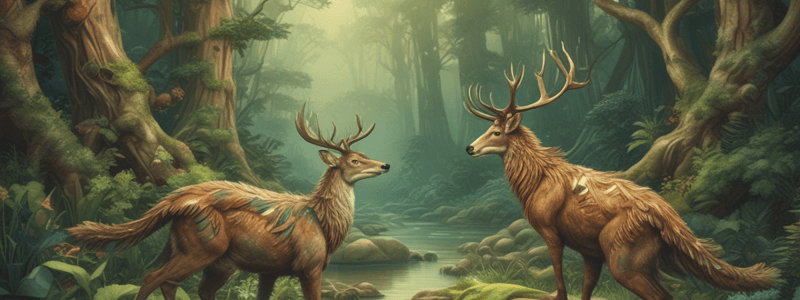Podcast
Questions and Answers
Match the following organisms with their characteristic related to speciation:
Match the following organisms with their characteristic related to speciation:
Ugandan cichlids = Speciation event interval of 4,000 years Some beetles = Speciation event interval of 40 million years Japanese land snails = Mechanical barrier to reproduction due to shell spirals Monkey flower Mimulus = Examined by Douglas Schemske and his colleagues
Match the following concepts with their description related to speciation:
Match the following concepts with their description related to speciation:
Gene flow = The process that must be interrupted for speciation to begin Genetic divergence = The process that reverses the speciation process Reproductive isolation = The result of genetic divergence between populations Mass extinction = An event that can affect the time for Earth's life to recover
Match the following examples with their category in speciation:
Match the following examples with their category in speciation:
Japanese land snails = Example of a single gene controlling speciation Monkey flower Mimulus = Example of plant genetic manipulation Ugandan cichlids = Example of polyploid speciation in animals Some beetles = Example of mechanisms of polyploidization
Match the following researchers with their contribution to speciation:
Match the following researchers with their contribution to speciation:
Match the following intervals with their characteristic related to speciation:
Match the following intervals with their characteristic related to speciation:
Match the following concepts with their relation to speciation:
Match the following concepts with their relation to speciation:
Match the following terms with their definitions in the context of evolutionary biology:
Match the following terms with their definitions in the context of evolutionary biology:
Match the following scientists with their contributions to the field of evolutionary biology:
Match the following scientists with their contributions to the field of evolutionary biology:
Match the following terms with their descriptions in the context of evolutionary biology:
Match the following terms with their descriptions in the context of evolutionary biology:
Match the following concepts with their descriptions in the context of evolutionary biology:
Match the following concepts with their descriptions in the context of evolutionary biology:
Match the following terms with their descriptions in the context of evolutionary biology:
Match the following terms with their descriptions in the context of evolutionary biology:
Match the following concepts with their descriptions in the context of evolutionary biology:
Match the following concepts with their descriptions in the context of evolutionary biology:
Match the scientists who coined the term 'punctuated equilibrium' with their contributions:
Match the scientists who coined the term 'punctuated equilibrium' with their contributions:
Match the concepts related to speciation with their descriptions:
Match the concepts related to speciation with their descriptions:
Match the types of speciation with their characteristics:
Match the types of speciation with their characteristics:
Match the sources of information about speciation with their descriptions:
Match the sources of information about speciation with their descriptions:
Match the concepts related to hybrid zones with their descriptions:
Match the concepts related to hybrid zones with their descriptions:
Match the questions about speciation with their descriptions:
Match the questions about speciation with their descriptions:
Flashcards are hidden until you start studying



